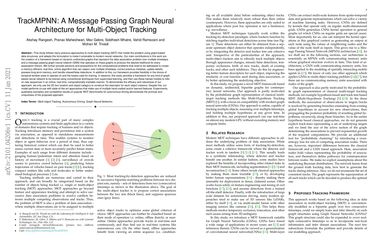TrackMPNN: A Message Passing Graph Neural Architecture for Multi-Object Tracking
This study follows many classical approaches to multi-object tracking (MOT) that model the problem using dynamic graphical data structures, and adapts this formulation to make it amenable to modern neural networks. Our main contributions in this work are the creation of a framework based on dynamic undirected graphs that represent the data association problem over multiple timesteps, and a message passing graph neural network (MPNN) that operates on these graphs to produce the desired likelihood for every association therein. We also provide solutions and propositions for the computational problems that need to be addressed to create a memory-efficient, real-time, online algorithm that can reason over multiple timesteps, correct previous mistakes, update beliefs, and handle missed/false detections. To demonstrate the efficacy of our approach, we only use the 2D box location and object category ID to construct the descriptor for each object instance. Despite this, our model performs on par with state-of-the-art approaches that make use of additional sensors, as well as multiple hand-crafted and/or learned features. This illustrates that given the right problem formulation and model design, raw bounding boxes (and their kinematics) from any off-the-shelf detector are sufficient to achieve competitive tracking results on challenging MOT benchmarks.
PDF Abstract



 KITTI
KITTI